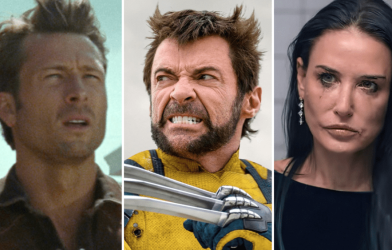
Renny Harlin and The Strangers Chapter 1 Still
Axelle/Bauer-Griffin/FilmMagic; John Armour/Lionsgate
After four decades of filmmaking, Renny Harlin isn’t slowing down in the slightest. The journeyman director, who’s most known for Die Hard 2, Cliffhanger, Deep Blue Sea and A Nightmare on Elm Street 4, is back on the big screen with The Strangers: Chapter 1, the first film in a trilogy that he’s already shot across 52 days in Slovakia.
Chapter 1 stays true to Bryan Bertino’s 2008 horror classic, The Strangers, only it imagines a scenario where an analogue for Liv Tyler’s character definitively survives the central home invasion, setting up Chapter Two and Three. Madelaine Petsch’s Maya is now filling that protagonist role, as her cross-country road trip to Portland results in her and her boyfriend (Froy Gutierrez’s Ryan) having to stay at a small town Airbnb due to car trouble. That’s when the Strangers crawl out of the woodwork to play their patented cat-and-mouse game.
Initially, Harlin was less fazed by the daunting task of shooting three films in less than two months. Instead, he was more concerned with the storytelling approach for the entire endeavor.
“Nothing is too ambitious for me. If it had been a straight remake or sequel, I would’ve definitely passed because, at this point of my life, I wouldn’t touch a classic like the original The Strangers,” Harlin tells The Hollywood Reporter. “But the idea of doing this four-and-a-half hour epic and splitting it into three chapters was a very unique opportunity to really have the time to explore the psychology of the victims and the perpetrators as well. So I thought I’d regret it for the rest of my life if I didn’t jump into this.”
Similar to Star Wars: The Force Awakens and its adherence to Star Wars: A New Hope, Chapter 1 follows suit with Bertino’s 2008 film, but all bets are off for Chapter 2 and Chapter 3. They are truly franchise departures, covering four more days of Maya’s fateful encounter with Man in the Mask, Dollface and Pin-Up Girl.
“In this case, we see that she survives, and just when she thinks she’s going to be okay, things get worse, because the Strangers just won’t give up,” Harlin says. “So chapters two and three go in completely different directions than the first chapter, and they become more epic.”
Below, during a recent conversation with THR, Harlin also discusses how energized he is to have a wide theatrical release again and how challenging the independent marketplace has become.
So when you were pitched this idea of shooting a Strangers trilogy simultaneously, did you dismiss it at first as being too ambitious?
Nothing is too ambitious for me. If it had been a straight remake or sequel, I would’ve definitely passed because, at this point of my life, I wouldn’t touch a classic like the original The Strangers. But the idea of doing this four-and-a-half hour epic and splitting it into three chapters was a very unique opportunity to really have the time to explore the psychology of the victims and the perpetrators as well. We could really take a deep dive into what makes them tick, who they are, what’s going on here, and use the original film as a jumping-off point. So I thought I’d regret it for the rest of my life if I didn’t jump into this.

John Armour/Lionsgate
I walked into this movie thinking it was a prequel, and that’s probably because of the 2018 movie and the tagline in Chapter 1‘s trailer: “Witness how the Strangers became the Strangers.” But the technology and cars quickly informed me that it was modern day. So would you call this more of a reimagining of The Strangers universe?
I would love to call this a reimagining. We basically felt that there’s a bigger story to tell. But we couldn’t take the original film and call Liv Tyler and Scott Speedman 16 years later to say, “Let’s continue from where you left off.” So we said, “Okay, if the Liv Tyler character, now played by Madelaine Petsch, lived, what would happen the next day?” So we wanted to continue from there, but we had to include the original film as a reimagined premise for this whole journey that we then take in chapters two and three. Chapter 1 is not a remake of the original film; it just has the touchstones of a young couple in a house during a home invasion and so on.

Froy Gutierrez (Ryan) and Madelaine Petsch (Maya) in The Strangers: Chapter 1
John Armour/Lionsgate
As you were in the middle of shooting three movies, did you find yourself developing even more respect for someone like Peter Jackson since he somehow did it twice with The Lord of the Rings and The Hobbit trilogies?
Definitely. It’s a huge undertaking, and it’s really challenging because you have to keep the arc of three movies in your head. And as we all know, you never shoot movies in chronological order. So you have to figure out how the story develops visually, how the characters change, where they are emotionally at each point and how you are going to keep the themes of claustrophobia and dread and fear alive at all times. We then wanted to make the subsequent movies feel bigger without falling into the trap of “bigger is better,” and therefore, we leaned into the sense of reality that is so crucial for these particular movies. So I loved it. It was an amazing experience. But when we were in those Slovakian forests at night, there were times where I felt like we were making Apocalypse Now and we’d never find our way back from the jungle.

Froy Gutierrez (Ryan), Madelaine Petsch (Maya) & Director Renny Harlin on the Set of The Strangers: Chapter 1
John Armour/Lionsgate
You shot scenes from different movies on any given day, so how did you organize each block? By Location?
It was mainly because of the locations. There are certain locations that appear in all three movies, though the movies are very different from each other visually and in terms of the storylines. We definitely don’t shoot in the original house much at all after the first movie, but for scheduling and financial reasons, once you go to one location and you take your whole circus of 300 people and all the equipment and the trucks and everything, you’ve got to shoot that location out. So, Monday morning, we’d be shooting chapter three, and Monday afternoon, we’d be shooting chapter one. And then Tuesday morning, we’d be shooting chapter two. So it was challenging for the crew and the actors and myself to always know where we were, emotionally. The character would be covered in blood and torn clothes and barely able to walk, and then two hours later, they are completely pristine and just arriving in town, all bright-eyed and bushy-tailed.
So I made emotional charts that covered four-and-a-half hours of story and 280 pages of script. For every moment, I charted, from zero to ten, the emotional state of the character and why and how it’s going to grow from there. When you’re making a movie, you can very easily get caught up in the moment and say, “We’re doing this scene, and this should be the biggest scene ever.” So you dial everything to ten, and then you just end up with scene after scene after scene where everybody is at ten. But that doesn’t give you any of peaks and valleys, and it all becomes very flat instead.
Chapter 1 is, by design, very reminiscent of the original movie, so how do the next two films deviate?
It’s one continuous story that covers five days in the life of the protagonist played by Madelaine Petsch, and like I said, she is basically the Liv Tyler character from the original movie. So, in this case, we see that she survives, and just when she thinks she’s going to be okay, things get worse, because the Strangers, the perpetrators, just won’t give up. They are hell-bent on getting her, and it’s her survival story, her psychological and physical journey into hell and back in trying to survive these five days while being pursued by them. So chapters two and three go in completely different directions than the first chapter, and they expand more and become more epic. We go to new sets and new environments, but the key for us was to always keep that sense of reality. We didn’t want to enter movie reality that is bigger than life. The idea is that this is all happening in a normal American town and its surrounding areas, and any one of us could end up here on any given day if we just take the wrong turn.

Madelaine Petsch as Maya in The Strangers: Chapter 1
John Armour/Lionsgate
Of your nearly 30 movies, you’ve shot nine in the last five years. How are you remaining this prolific?
Well, in Hollywood and in cinema in general, I always say that you have to be able to reinvent yourself. Everything develops and changes: the technology, the distribution models, the taste of the audience, the genres. And if you love what you do, you have to be able to adapt. You have to be able to react to the realities in your world, and you have to remain curious. I love nothing as much as moviemaking and storytelling, and that’s where I get my kicks. That’s where I get my high. That’s when I’m happiest.
Hollywood is not an easy place, and you have your ups and downs, but I’ve never let cynicism take over or affect my view of life. I’ve always stayed curious, and I feel like I’ve always had the same childish imagination. I still look at life and feel the same way I did 40 years ago when I was starting out. So I’m just hungry for new stories. I’ve mostly worked in action and horror, and whenever I read a script that excites me, I then try to put it together.
There’s many ways to put movies together and get financing for them, but studio movies are not easy to do anymore because there are less studio movies than there used to be. There was a time when studios would make 30 movies a year, and now they maybe make eight. And they are comic book-superhero movies or tentpole IPs that take a massive share of the studio business. So there’s different ways of discovering independent financing and getting your stories made and told, but then there’s so many different distribution models now.
If we speak honestly, every filmmaker still dreams of their movie being theatrically distributed. There’s nothing like that moment of having your movie projected on the big screen with an audience sitting in the theater. Streaming has obviously helped a lot of people tell stories, and it’s helped a lot of us find other ways of distributing movies, but the theatrical experience is still something incredibly special. For independent movies, it is not easy to get outside the studio system. You might get a limited release or something like that.
But I consider myself extremely fortunate and privileged that I have The Strangers: Chapter 1 now and a wide theatrical release, and I hope that it proves to the studio that it’s worth making these kinds of movies that are not very expensive to make. The marketing is maybe the most expensive part nowadays, but it’s worth it. People will come to the theaters when it’s the type of movie that validates that communal experience of seeing it together.
***
The Strangers: Chapter 1 opens in theaters nationwide on May 17.









